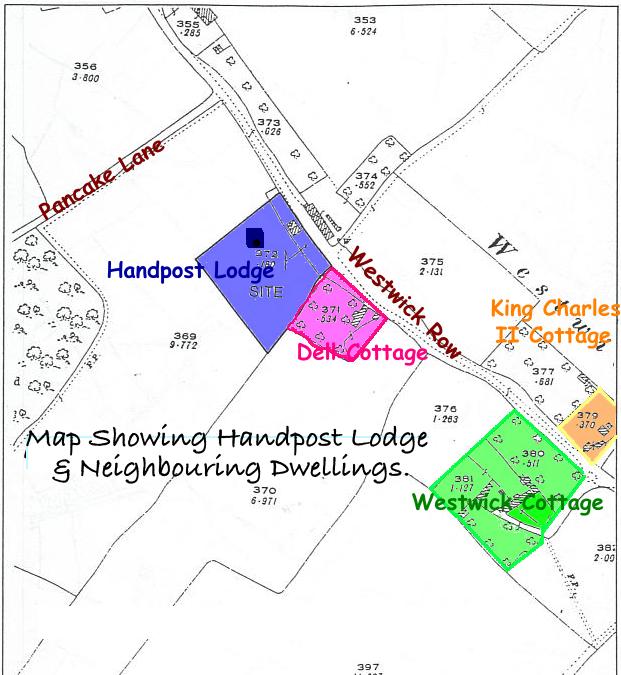Handpost Lodge Westwick Row was the home of Brigadier and Mrs R. Wood, and in order to meet death duties was sold and the grounds redeveloped following their deaths in the late twentieth century. The house itself was built in the 1930’s, and though a lovely property was not particularly remarkable except for the delightful grounds which had been laid out around it. Today five very large and equally desirable executive residencies stand in what has been called Handpost Lodge Gardens. Nevertheless, what has made Handpost Lodge remarkable and important for out local heritage, is what was discovered in the development process.
My own research had led myself and others to the discovery that the original site for the Manor of Westwick was in all probability at Westwick Cottage, which was now known to be one of the earliest continually lived in properties in the country, parts of it being reliably dated by dendro-chronology to the late 12th very early 13th century. Its now a Grade II* listed building. Westwick Row was easily datable to the early middle ages, and in all probability to the Iron Age, as is Pancake Lane, originally known as Twitchey or Twitchell Lane. King Charles II Cottage is also a listed building dating to the early 17th century, and I have recently succeeded in getting Grade II listing for Dell Cottage, dating to the late 16th early 17th century. Therefore when planning permission was applied for I objected on the grounds that such development might damage our heritage, as did local residents and the Leverstock Green Village Association.
Outline Planning permission was eventually granted in 1997 on condition that a programme of archaeological investigation took place in line with PPG16. Bedfordshire County Archaeology Service were commissioned to undertake this in July 1998. Given the work I had already done on Westwick Row, it was expected to find archaeology dating to the medieval period, and possibly some Late Bronze Age given that Arthur Evans had uncovered a hoard somewhere along Westwick Row in 1881. What no one had anticipated finding, despite proximity to St. Albans, was Roman artefacts. Yet this is exactly what was found along with Iron Age pottery. Strangely no Medieval artefacts were found, though I suspect that had work been carried out in the 1940’s and 50’s when the garden was being developed the results may have been different. I recall the owner of Westwick Cottage telling me that when she & her husband, and her neighbours were developing their gardens at that time they all threw out many barrow loads of pottery and other “rubbish”, unfortunately never thinking it may have been important.
Only two small trenches were dug and 5 even smaller test pits were examined, but this still yielded a total of 45 vessels represented by 81 sherds of pottery; in addition 20 fragments of Roman building materials including fragments of box flue tile, tegulae, imbreces and bricks were found. A Roman blue glass bead, and a highly corroded square shank iron nail were also found. The conclusion was obvious, “…the presence of Roman roof tiles, bricks and flue tiles suggests the presence of at least one substantial structure in the vicinity. This clearly had a tiled roof and perhaps more importantly a hypocaust heating system,” in other words a Romano British Farm or Villa.
Eventually full planning permission was granted and work was expected to begin late December 1999/January 2000 subject to certain work being undertaken. Unfortunately the builder started to work on the footings etc. WITHOUT carrying out the necessary work. Luckily, watchful neighbours realised this and reported it to DBC. As far as I am aware this was the first time and possibly still is the only time, Dacorum Borough Council were able to have an High Court Injunction enforced, and work was stopped for a while. Regrettably though, inevitably some of the archaeology was lost, and it is impossible to say how important it may have been. Following this, work continued with the correct archaeological presence on the building of the five houses. The cul-de-sac of houses, now called Handpost Lodge Gardens, is now complete.
Details of the Service Report on Handpost Lodge by BAS, dated March 2001 can be read on my website at http://www.bacchronicle.homestead.com/Roman.html . The further work undertaken whilst building was in progress did not turn up much, however altogether the site had yielded 6 registered artefacts in addition to 4 iron nails and all the ceramics. These were: a Glass cylinder bead, Window glass fragment, 2 x Iron hobnails, a Lave quernstone fragment and an iron hasp. Investigations have revealed at least three phases of human activity: Late Iron-Age, Early Roman and Late Roman, with sufficient pottery and general building material to indicate a substantial building in the area, probably a Romanised farm or villa. The presence of pottery and general building debris is often used by archaeologists to classify sites such as Romanised farms (villas). Sadly we are unlikely to find the exact location of what for argument sake I shall call the Westwick Villa, as Handpost Lodge Gardens was the last area in the vicinity to be developed, with the most likely locations already covered in the houses of Edenhall Close, Badgers Croft and Delmar Avenue.
Handpost Lodge was only part of the Leverstock Green environment for about 6o years, yet its demise resulted in knowledge of another, and far more important Lost Property, that of a hitherto unsuspected Roman villa.

